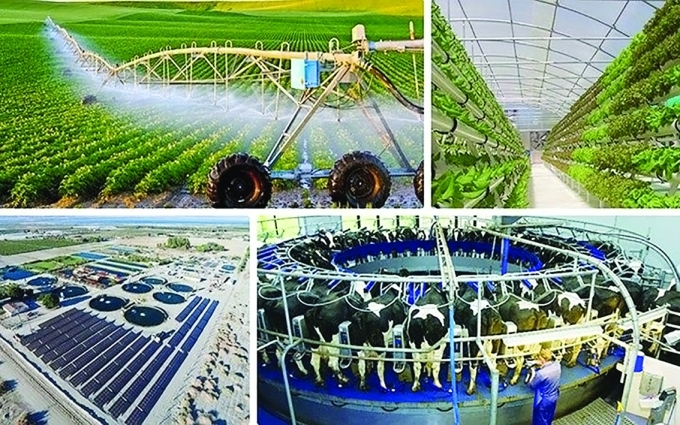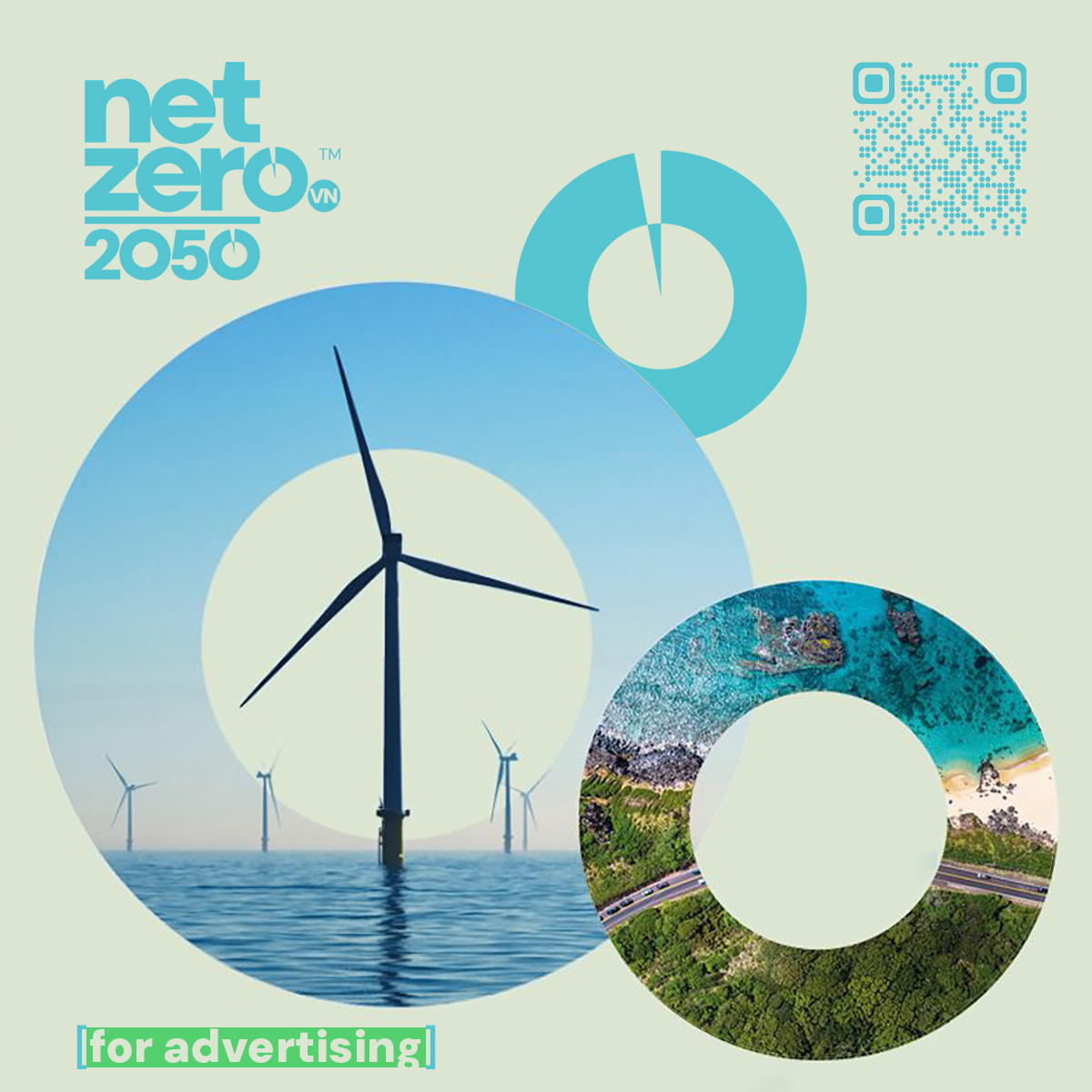
At the 26th United Nations Climate Change Conference of the Parties (COP26), held in Glasgow, UK, from October 31 to November 12, 2021, Prime Minister Pham Minh Chinh announced Vietnam’s commitment to reach net-zero emissions by 2050, with financial and technological support to come from the international community. According to experts, this commitment can only be achieved with the partnership of global stakeholders.
Immediately after COP26, the Prime Minister issued a plan to implement the commitment, focusing on five main groups of solutions: energy transition (gradually reducing reliance on fossil fuels, and promoting renewable and clean energy); efficient and economical use of energy alongside fostering a green and circular economy; forest and ecosystem development to absorb carbon; carbon capture and storage; and carbon pricing and carbon market development.
Key to net-zero
Developing a carbon market is one of the key solutions to help Vietnam meet its net-zero target. At the recent Vietnam Carbon Market Forum 2025, Dr. Nguyen Tuan Quang, Deputy Director General of the Department of Climate Change at the Ministry of Agriculture and Environment (MAE), said 80 economies have already adopted this mechanism. Carbon pricing alone has helped control about 28 per cent of total global greenhouse gas emissions, equivalent to roughly 12-14 billion tons of CO₂ a year. The global carbon trading market is now valued at $152 billion.
In Europe, a carbon market has been in place since 2005, helping cut emissions in the region by some 37 per cent. Singapore’s carbon tax is another effective measure to control emissions, while China and other countries are also actively developing carbon markets.
In Vietnam, Prime Minister Chinh signed Decision No. 232/QD-TTg 2025 on January 24, 2025, approving the Project on the Establishment and Development of a Carbon Market in Vietnam. The plan calls for a pilot phase to 2028, with official operations to commence in 2029 and eventually integrate into the global carbon market. Ministries and agencies are now working urgently to finalize the legal framework in order to begin the trial phase by the end of this year.
On the legal front, Dr. Quang noted that Vietnam already has Government Decree No. 06, issued on January 7, 2022, on greenhouse gas emissions reductions and ozone layer protection. More recently, Government Decree No. 119/2025/ND-CP, issued on June 9, 2025, amended several provisions of Decree No. 06.
The Ministry of Finance has submitted to the Prime Minister for approval a decree on establishing a carbon trading exchange. This exchange would manage and trade domestic carbon credits in line with national standards, while also complying with international frameworks such as Articles 6.2 and 6.4 of the Paris Agreement, as well as independent mechanisms like Verra and Gold Standard. All credits will be registered on a unified system to ensure centralized and transparent management.
The MAE is also drafting a decree on the international exchange of greenhouse gas emission reductions and carbon credits. According to the Department of Climate Change, these decrees are crucial because if Vietnam trades credits internationally with corresponding adjustments, the associated reductions will no longer count toward its national targets but instead be credited to the purchasing country. Without strict controls, Vietnam risks “losing its share” of pledged reductions, which could directly affect its ability to reach net-zero emissions. The Department said the goal is to complete the full legal framework and technical infrastructure in 2025 so that the carbon market can begin trial operations before the year comes to a close.
Powering green transition
Vietnam’s pledge to achieve net-zero emissions by 2050, announced at COP26, was an earlier and stronger commitment than many other developing countries made. Experts note that this is an opportunity for Vietnam to reposition itself as a globally-responsible country while also posing major challenges in terms of resources.
In 2009 in Copenhagen, developed countries pledged to mobilize $100 billion annually to support developing nations. This target was only met for the first time in 2022. At COP29, the figure was raised to $300 billion a year, with a projected increase to $1.3 trillion by 2035. A significant portion of this will come from innovative financing sources, with the carbon market identified as a key tool to mobilize financial resources for the global green transition and emissions reduction process.
Global experience shows that three main groups of solutions are prioritized for financial support: emissions mitigation, climate change adaptation, and combined solutions. Priority sectors include energy, transport, agriculture and forestry, water, and other areas related to natural resource use.
However, the least-developed countries secure only about 3 per cent of total global climate finance, while lower-middle-income countries account for around 27 per cent. Vietnam, despite signing the Just Energy Transition Partnership (JETP) and receiving a commitment of $15.5 billion, still faces significant challenges in absorbing green finance and technology, particularly due to limited human resources capable of implementing transition solutions.
According to the Institute for Strategy and Policy on Agriculture and Environment at the MAE, climate finance not only helps protect the planet and cut emissions but also unlocks significant economic opportunities if used effectively.
Under its Nationally Determined Contribution (NDC), Vietnam is projected to emit over 900 million tons of greenhouse gases under a business-as-usual scenario. In the updated 2022 NDC, it pledged to cut emissions by 15.8 per cent. With international support, its reduction could rise to 43.5 per cent, equivalent to 45 million tons of CO₂.
This clearly shows that achieving the NDC will require concrete financial solutions, without which commitments will be difficult to realize. Associate Professor Nguyen Dinh Tho, Deputy Director of the Institute for Strategy and Policy on Agriculture and Environment, emphasized that the carbon market is considered one of the key solutions for Vietnam to fulfil its NDC pledge.
Some experts see carbon credits as becoming a kind of currency. Mr. Le Quang Linh, Carbon Project Development Consultant at the Giant Barb Science & Environment JSC, believes that participating in international cooperation mechanisms on carbon markets under Article 6 of the Paris Agreement is crucial for Vietnam to meet its national emissions reduction targets and mobilize resources. Article 6 provides a framework for countries to voluntarily cooperate to achieve their NDCs, encouraging investment in emissions reduction projects through international collaboration, enhancing transparency, and avoiding double counting.
Active participation in both Article 6.2 and 6.4 can help Vietnam mobilize international finance and technology to cut emissions, meet the NDC and net-zero goals, and enhance the transparency and credibility of the carbon market. According to Mr. Linh, effectively mobilizing and using international finance is key to unlocking the full potential of Vietnam’s carbon reduction projects.
Issues to note
According to experts, there are two main approaches to the carbon market: carbon taxes and carbon trading, which includes both compliance and offset markets. In major emitting sectors, carbon markets play a critical role in meeting emissions reduction targets.
A notable feature of Vietnam’s NDC is that each sector has a specific cost estimate, a financial support scenario, and corresponding outcomes if international resources are available. However, mobilizing external green finance remains challenging due to limited domestic capacity in human resources, green technology, and capital absorption.
Another challenge is the gap between the cost of reducing emissions and the price of carbon credits. Therefore, pricing carbon credits in line with actual costs is crucial for feasibility.
In agriculture, the final marginal cost of cutting 1 ton of CO₂ can reach $300, while agriculture and forestry carbon credits currently trade internationally for just $1-$1.6 per ton. Selling credits at low prices without meeting emissions commitments could cost Vietnam up to $300 per ton in compensation, according to the 2022 NDC.
Therefore, when entering the carbon market, it is essential to weigh opportunities, costs, and benefits, both to tap into climate finance and to promote technology transition and emissions reduction while mobilizing resources for the country and its businesses. If Vietnam knows how to leverage opportunities from carbon credits, connecting offset and compliance markets, as well as domestic and international markets under Article 6 of the Paris Agreement, the financial gain for businesses could be 20-30 times higher than the standard credit price.
Globally, the carbon market has mobilized $373 billion since 2007, with $70 billion raised in 2024 alone, underscoring the role of carbon finance in supporting global climate goals.
In addition, transaction price levels show that emissions reduction potential rises in line with price tiers. Each price point corresponds to different groups of solutions, from low-cost, easy-to-implement measures to large-scale, high-tech solutions. This means the carbon market is not only a tool for pricing emissions but also a lever to shape green transition pathways tailored to each country’s and enterprise’s capacity.
As such, carbon pricing and market establishment are essential. The Institute for Strategy and Policy on Agriculture and Environment considers the development of the carbon market to be urgent and not to be delayed; an important opportunity to mobilize resources for the green transition. If Vietnam does not seize the opportunity, those resources will go to other countries.
Developing the carbon market will not only help cut emissions but also deliver tangible economic benefits for businesses, citizens, and the government. In practice, companies that invest in technology upgrades and reduce emissions can sell the resulting carbon credits to others that have yet to, or cannot, transition. Whether to invest in technology depends on the market carbon price: if the credit price exceeds the cost of upgrading, companies should invest; if it is lower, they may buy credits to meet short-term obligations and delay investment.
This, experts note, is the logic of the carbon market, where price signals guide participants’ behavior. Vietnam’s roadmap is to complete its pilot phase by 2028 and begin full operations in 2029, similar to the early development of its stock market.
The carbon market will require a well-developed legal, financial, and technical framework. Once established, Vietnamese companies will be able to participate in trading, just as they did when the stock market was first introduced.
When developing the carbon market and trading credits, Dr. Quang stressed that each carbon credit must be generated according to a recognized standard and methodology, ensuring transparency and compliance.
Additionally, all credit transactions must be under unified State management. Without effective regulation, uncontrolled sales abroad could prevent Vietnam from meeting its national emissions commitments and leave the domestic market short of credits needed by industries to fulfil their obligations.
Nhi Anh




